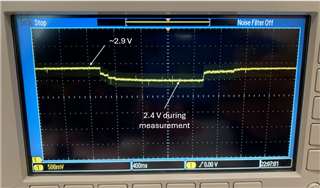Tool/software:
Hello,
We are designing a coin cell powered device that takes periodic measurements. The measurements require a 2 second pulse of 16.5 mA, and the device consumes around 0.08 mA between measurements.
Since all ICs on the board operate at 3.3V we decided to use the TPS61299 boost converter to step up a 3.0 V CR2032 coin cell battery. The boost converter schematic is set up as follows.

We noticed that with this setup, the input current of the TPS61299 is elevated to around 24 mA during measurements, although the device itself is only consuming 16 mA. The same elevated current is not observed when we use a LiPo battery as input for the TPS61299 in place of a coin cell battery. The coin cell battery voltage with measurement load is below.

We see the battery voltage dips to 2.4 V during measurement load due to battery ESR, but we did not expect the TPS61299 to be inefficient with this input voltage level. What could be causing the inefficieny in the circuit and can we improve this by selecting a larger input capacitor? Are there alternatives to the TPS61299 that are more appropriate for our use case? As a note, in the future we are also planning on switching from a CR2032 to a CR2430 for bigger capacity.
Thank you!

